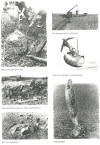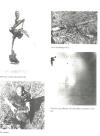 page 98
page 98
 page
99
page
99| Back to B-17 GSH 42-3486 mainpage |
Aircraft recovery
The aircraft came to rest at the bottom of the Zuiderzee/IJsselmeer, about 5
meters below the surface, where it rested until 1968/69.
The last resting place of the airplane became dry land due to the land
reclamation projects of the Zuiderzee. The dikes around what would become the
Oostelijke Flevopolder were closed in 1956 and the polder fell dry in 1957.
First farming started in 1962, but on limited area's. It took to about 1968
until the area of the crash site was "domesticated".
Due to the still swamp like terrain, and other priorities, it was not possible
to execute all the excavation work in just one season, and it took several
expeditions to remove the wreckage, both in 1968 and 1969 [1]
Here two pages from the book of S.L Veenstra,
"In de schaduw van de glorie - Overzicht van
vliegtuigbergingen in Nederland 1960-1977" [2], showing the
recovery.
There were some remarkable finds during the recovery. During 1968 a
lump of mud was found containing a camera. Unfortunately the camera was opened
and most of the film exposed. Only one picture could be saved and is shown on
the page 99 above. It shows another B-17 flying below 42-3486, likely taken
above or near the target.
During the 1969 recovery a fully equipped lifeboat was found, still containing
all emergency rations.
About three
months after the wreckage was officially cleared (June 27th, 1969) , the (remains of the) body of co-pilot
Roy Peterson were found. They were found by a
farmer, while ploughing the soil for the first time since prehistoric times,
several hundred yards from the position of the wreckage.
The pictures also show the dramatic forces sustained while hitting the water.
Only relatively small pieces of wreckage were found. Some propellor blades
severely bent.
The exhaust manifold serial plate on the foirst page was found on "Kavel
E-61" by a farmer.
| [1] | Described in the book of S.L. Veenstra, Mr Veenstra was actually in charge of the recovery. |
| [2] | Unfortunately, the book of Veenstra has been published privately and is very difficult to obtain. |